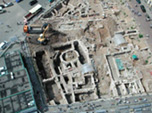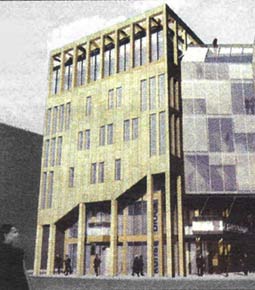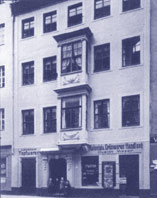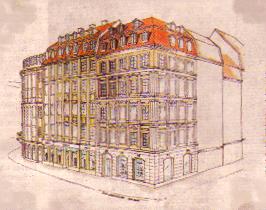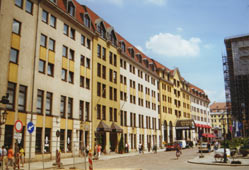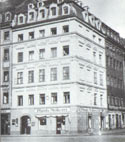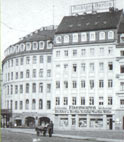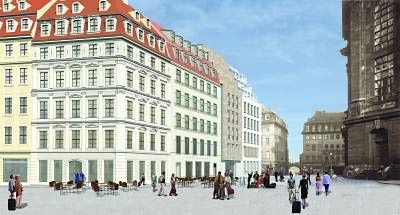
foto: q-f.info
- Juli 2003, Visualisierung: Hummel / v. Döring
mehr
aktuelle Bilder der Planungen
offizielle Website
"Quartier an der Frauenkirche" (QF):
www.q-f.info

Detailed Plan for
the Area of Augustusstrasse - Töpfergasse - at the Frauenkirche
At
the site of the former parking lot in front of the Hilton Hotel there
was, until 1945, an enclosed block of houses which bounded the Neumarkt
on the north side. The northwest corner house of this block, erected
at the end of the 17th century at Augustusstrasse No. 4/corner Töpferstrasse
, was consciously placed there as a point of viewing interest at the
end of the Fürstenzuges or "Princes Way". In 1986 the new building
housing the present day Hilton was erected on the north side of Töpferstrasse.
Of the houses on the opposite side of the street, only house No. 12
had sufficient documentation to justify a reconstruction. This five-
axis structure had retained its original state as it was at the time
of its construction in 1713 even down to the ground installations.
Such houses as this, with simple stucco facades, were frequently represented
in the Neumarkt district and played the role of a modest foil for
the more richly decorated buildings. The houses at Neumarkt 1 through
3 were among the most important urban achievements in this entire
city quarter, and their facades, together with that of the bordering
house at Augustusstrasse 8, are to be reconstructed. The "Weigelsche
Haus" at Neumarkt No. 2 was erected in 1770, possibly by Samuel Locke.
Christian Heinrich Eigenwillig was the architect of the adjacent corner
house on the west side at Neumarkt 1. This house, built for the mayor
Herr Borrmann, was enlarged in 1769/70 and became the Hotel Stadt
Berlin, one of the best hotels in Dresden, in which , among others,
Chopin and Dostoyewski lodged. Its curved facade in a segmented arch
form which dominates the view of the Neumarkt from all of the side
streets was one of the most successful architectural and urbanistic
solutions of the reconstruction period after 1760.
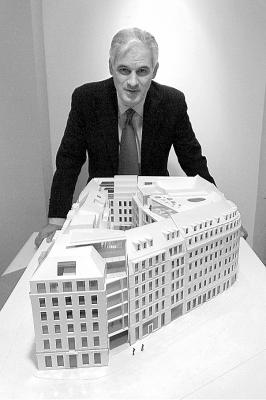
Investor: italien Arturo Prisco (60)
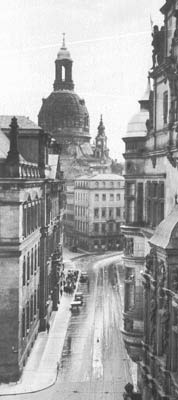
Foto: 1930

Johanneum (links) und Augustusstraße, etwa 1929
The key elements underlying the decision to sell the area on the Neumarkt to Arturo Prisco were his investment concept, his credit standing and his references. In Munich, Prisco operates the largest private textile fair in the world. In Dresden, he has already refurbished several buildings true to their original status.
In the Neumarkt, Prisco would like to create a combination of houses rebuilt with historical accuracy together with carefully enlarged new ones. On the ground floor, small, high quality fashion shops would be housed, while in the interior courtyard there would be modern arcades with an international flair. In addition to about 40 apartments, there would also be a five star hotel (housed in the so-called "Hotel Stadt Berlin" building).
During the years 2001 and 2002 the cellars which still remained were excavated and initially were supposed to be integrated, at least to some extent, in the new construction. However, after the flood of 2002 all existing foundation walls in this land parcel were destroyed. In 2003, an architectural competition for this quarter took place which produced some results worth mentioning, but nevertheless also showed anew that many architects even today have not understood that when it comes to the Neumarkt, the key goal is to win back the lost city center of Dresden, not to create a monument to the architects themselves.
Thankfully, the facades of the buildings fronting on the Neumarkt (Augustusstrasse 8, Neumarkt 1 to 3) will be completely reconstructed by the client, Mr. Prisco. This is first and foremost thanks to the efforts of the GHND in addition to the receptiveness of the client, since without this effort, only the rebuilding of the so-called "Weigelsche Haus" was contemplated on the part of the city government. Towards the Töpferstrasse, a small scale modern building, done in a suitable style, will return a certain flair to the Neumarkt area. Unfortunately, however, the historic reconstructions will be limited to four - not even the precisely documented ground plan of the "Weigelsche Haus" will be carried out on the part of the city.
Nevertheless, seen in its entirety, the "Prisco Area" promises to become a new high quality part of Dresden. Although the project was really supposed to be finished before the Frauenkirche, a substantial construction delay has led to a situation where the opening cannot be reckoned with before the middle of 2006. As of the middle of May 2005, the basement floors are partly completed, but a large hole still yawns at the place where in a few months thousands of people will be following the dedication of the Frauenkirche. Only towards Töpferstrasse, at least, has the ground floor level been reached.
Januar 05
An den Kellergeschossen wird gearbeitet. Einige Architekten stellen
Ihre Bauobjekte aus der Töpferstraße im Internet vor:
- www.rohdecan.de
(siehe 2004 - Quartier an der Frauenkirche)
- www.wp-net.de
(Wörner & Partner) (Abbildung ebd.)
- www.pfauarchitekten.de
(Pfau Architekten)
- 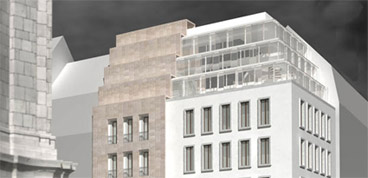
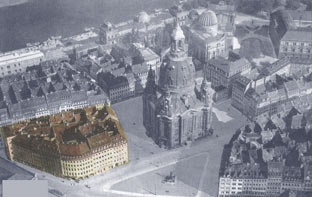 "Prisco"-
Areal auf dem heutigen Hotelparkplatz vor dem Hilton
"Prisco"-
Areal auf dem heutigen Hotelparkplatz vor dem Hilton